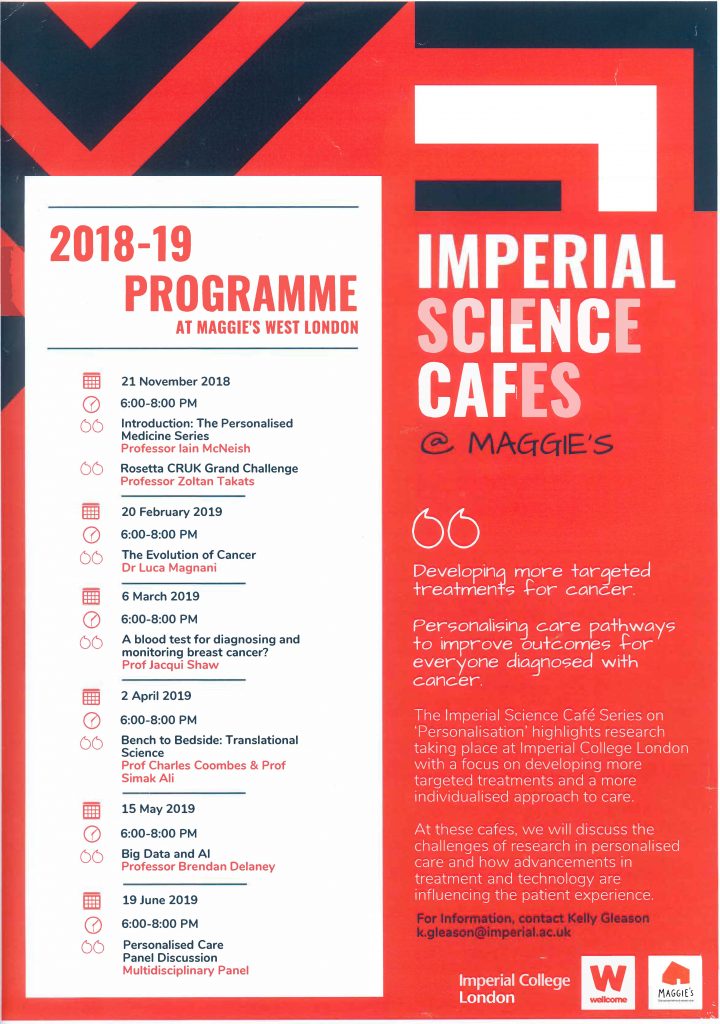Our series was formally launched with introductions from Kelly Gleason, Cancer Research UK senior research nurse, and Iain McNeish, Head of Division, Cancer, (both at Imperial College London & Imperial College Healthcare NHS Trust). Later we heard from Adam Taylor (National Physical Laboratory) about work in the Rosetta Team under Josephine Bunch which is supported to map cancer through the first round of CRUK Grand Challenges so as to improve our understanding of tumour metabolism (https://www.cancerresearchuk.org/funding-for-researchers/how-we-deliver-research/grand-challenge-award/funded-teams-bunch).
To begin with, we learned about the breakthrough presented by tamoxifen in the development of personalised cancer medicine before hearing more about the infinite complexity of cancer biology. Twenty years ago, treatments were given to everyone with an anatomically defined cancer. This was frustrating since staff knew from experience that the treatment wouldn’t work for most people and many patients were disappointed. The introduction of tamoxifen led to stratification based on a common oestrogen receptor. Later, in ovarian cancer, it became clear that PARP inhibitors could be used successfully on approximately 20% of patients, who had inherited particular susceptibilities (in BRCA-1 and BRCA-2). Nonetheless, sub-group or stratified medicine is a long way from the goal of delivering unique treatment to everyone’s unique cancer.
This complexity is clear from the preliminary application of a range of integrated techniques by physicists, chemists and biologists in the Rosetta Team, as Adam then explained. Collaborators map and visualise tumours as a whole in their particular environments along with their constituents down to the level of individual molecules in cells. In combination, these measures give both a detailed picture of different tumour regions and a holistic overview. Amongst the many techniques are AI methods that we have encountered through Amazon or Tesco platforms which find patterns through reducing complexity. For example, 4,000 variables are reduced to three coloured axes that label different chemical patterns in one application of varied mass spectrometry techniques. You can find regions of similarity in the data by colour coding, and explore their molecular characteristics.
Amazon has applied non-negative matrix factorisation to predict how likely we are to buy a particular item once we have bought another specific item. A similar approach enabled McNeish’s group to find patterns among samples of ovarian cancer that had all looked different. The team traced 7 patterns driven by 7 mechanisms among these samples.
Embedded in the study of cancer’s biology and chemistry, data scientists ‘know that these are not just numbers. They know where the numbers come from and the biological and technical effects of these numbers.’ Non-linear methods such as t-SNE help in the analysis of very large data sets. Neural networks have also been developed to use in a hybrid approach where a random selection of data is analysed with t-SNE (stochastic neighbourhood embedding) to provide a training set for neural network applications which are then validated using t-SNE methods on another randomly selected chunk of data.
This approach combines fine-grained detail with broad pattern recognition in different aspects of tumour metabolism. It might lead to the development of a ‘spectral signature’ to read the combined signature of thousands of molecules at diagnosis.
At the end of the evening, most of us revealed anxieties about the attribution of a wholly singular status through personalising practices. Those affected by cancer wanted the ‘right’ treatment for them but we were reassured by the recognition that we also share features with other people. We appreciated the sense of combining and shifting between the ‘close up’, which renders us unique, and a more distant view, where we share a great deal with others.
Many thanks to Maggie’s West London for their hospitality.
